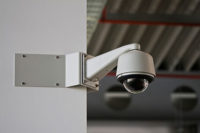
Martin Gren, co-founder and board of director member for Axis Communications, says that surveillance video technology will continue to move toward consumer and IT standards such as H.264 and HD, giving security professionals the look and feel of high-end home entertainment systems and mobile devices.

Jade Morris, CEO of QuickNets Communications, believes that changes in technology’s value to the customer ultimately drove its adoption and has helped Nevada Energy to do more with less.
Now, though, it appears that the recession is part of a perfect storm that increased IP sales in 2009 while analog video systems declined. Is this the year that you and your organization make IP video the standard system specification instead of the exception?
What is driving the continued growth of IP as a percent of video surveillance systems sold and installed? First, look at what you are being asked to do as a result of the recession: more with less. And the reality of that request is a heavy reliance on surveillance systems to be your remote eyes and ears, thereby empowering fewer security officers to be more effective and efficient. And the more surveillance you employ the more video you create and the less that your officers can actually observe.
That means that your video surveillance system needs more functionality to be an effective solution. That demand for functionality is driving analog systems toward economic obsolescence because 1) the ongoing cost of operating a legacy system meets or exceeds any additional investment in a new IP system and 2) the functionality of the legacy system restricts performance and your ability to provide security as consistently and constantly as you need to achieve your goals.
In the late 1980s, Sun Microsystems co-Founder and CEO Scott McNealy proclaimed, “The network is the computer” as distributed computing was allowing us to do amazing new things like send a word document from one person’s PC to another person’s. Today’s growth of network video and the rise in cloud computing are clear signs that your next upgrade will be based on IP technology, which is being based on consumer standards that mean broad manufacturing applications and open systems which in turn, reduces the cost.
Network video forecasts never seem to change; we just push the years out on the Y-axis when the forecasts do not come true. But this time it is different. In 2009, it appears that analogue camera sales declined 15 percent, while IP or network camera sales increased about 15 percent. IP did not enjoy the prior 40-percent plus year over year growth it had, but when you compare it to analog, its growth is impressive. Based on 2009 results, the forecast is that IP will pass analog camera sales in 2013.
Why is this important to your organization? While you never want to be on the bleeding edge of technology, you do need to understand and adopt technologies that drive security performance and reduce costs. Again, it’s about doing more with less.
Here are a few trends for your consideration when reviewing your current video surveillance system in alignment with your security program objectives.

Dan Tullis of Nevada Energy spoke about the challenges of convincing management at the utility that technology upgrades can be a cost-effective investment.
Functionality
There is nothing wrong with my turntable, except that it is not mobile, doesn’t play my iPod songs and I cannot download songs to it. And the albums available to play on my turntable are scarce, at best. It works great with low functionality. That, in a nutshell, is the driver for IP over analog.Jade Morris, CEO of QuickNets Communications, a leading systems integrator based in Ventura, Calif., presented “Game Changers” at the recent Axis A&E Conference. His discussion of the IP phone, mobile phones, the iPod and ultimately, IP security outlined how significant changes in technology’s value to the customer ultimately drove its adoption. Specifically, he related these changes to his recent project with Nevada Energy and its system-wide security upgrade to use IP networks and surveillance systems to “do more with less.”
Dan Tullis of Nevada Energy spoke candidly about the challenges of working the upgrade through general management at the company. “There was a perception that Ethernet is in some way, ‘bad’ and that Digital was ‘good.’ So we had to stop writing and saying Ethernet and make sure that we talked, ‘Digital.’ Specifically, we talked about its benefits being cost effective and that it has an economy of scale, which we needed to utilize for this project.”
“Second, we focused on functionality and the quality of the security program. We did a lot of internal communicating to move the discussion toward the quality of the security program as a result of this investment and moved the focus of the discussion away from the cost of the investment.”
Today, the Nevada Energy security team uses touch screens, not joy sticks. But the new system didn’t require significant training. The technology improved functionality without adding complexity. Noted Morris, “The application of technology is key; not the technology itself. In some cases, less is more.”

The demand for functionality is forcing analog video systems toward obsolescence while increasing sales and installations of IP systems.
What about the Technology?
Security video technology is strongly tracking consumer standards such as H.264. Officers can have the beneficial experience of watching consumer TV quality images versus traditionally poor quality analog images. Plus, networked video is mobile and easily distributed to handheld devices. Simply looking back at how digital cameras quickly supplanted film cameras gives you a solid example of what is anticipated in our market (see chart on following page). Technology that offers convenience, reduced cost, functionality, portability, content sharing, storage, instant availability and simple query search made the additional cost of a digital camera worth the investment to the consumer (Similarly, the iPhone is among the most expensive mobile phones sold as a result of consumer perceived value). And many of the features digital consumer cameras offer include the functions that you need in your surveillance system.What are the technology keys to the fast IP adoption growth as a result of the recession?
The H.264 compression standard has leveled the cost of the playing field. In a recent exercise, Kevin Marier, president of Security Consultants International (and publisher of IPVS Magazine), sent an RFP on a surveillance system in both analog and IP to several design and installation companies. The analog solution required eight terabytes of storage (8TB) and the IP system required two terabytes of storage. The bottom line? The IP system bids averaged 9-percent less (about $13,000 on a $140,000 project) than the analog pricing. While the pricing could be close enough to be called a technical ‘tie,’ the functionality and future flexibility of an IP system cannot be overlooked.
H.264 compresses the video data and eliminates time and cost related to transmission. Second, analytics combined with H.264 ramp up the economic model for you. Analytics in the camera identify if the picture (data) has changed or not. And it only transmits or sends new video to the monitoring center as necessary. And because something has changed and is new, the system can alert the officer to ‘look at this,’ which adds more economy of scale and value.
As cloud computing and software as a service emerge as real-world solutions for your security platform (if you have a monitoring contract, you are already using cloud computing), the investment in Capital and Operations budgets will be less of an issue. This is another example of the IT-izing of security, but via the Finance department. With a cloud-computing model, you can lease your security system and budget a fixed cost/fixed maintenance program. And like a leased car, you can give it back and replace it with next-generation technology when the lease ends.
Power over Ethernet is another key trend driving value. PoE simply provides the power to run the security device over the network connection instead of requiring a separate power source. PoE means you can have a lot of technology on a camera or card reader that was not available before. It enables more functionality at a lower cost through an IP system. With the new PoE+, PTZ cameras as well as outdoor cameras can be powered over the Ethernet, further reducing the IP system cost.
HDTV is another consumer standard that is working its way into the business world. High Definition gives your officers and your archive the consumer experience you enjoy at home or a local sports bar. As HD becomes the next consumer standard and ultimately makes its way to the business world, quality images will enable greater response and improved security performance.
Storage, typically, is a substantial cost of your video surveillance system. But in the research done by Marier, an eight terabyte storage specification was reduced to two terabytes. How did this happen? The correct answer is, “all of the above.” It involved greater compression and the use of analytics. Add to that the cost savings provided by the application of PoE and cloud computing and you start to understand why the shift to IP is accelerating
Technology transfer, the amount of time and energy it takes we humans to learn, adopt and utilize new technologies and systems, have slowed IP adoption. The Axis A&E Conference is an investment in the future of the market, bringing experts and colleagues together to learn, touch and discuss network video systems and applications. As more channel companies understand the economics and technology around IP, the more it will be specified and adopted. After all, a turntable will never have the functionality of an iPod.

